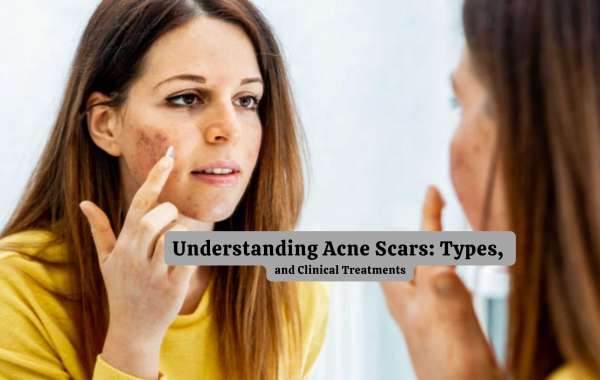Acne scars on the face or other visible body parts can make people feel worried or self-conscious about their appearance, which is why they may seek aesthetic dermatologist procedures to remove acne scars.
Here in this article, Dr. Niti Gaur dermatologist at Citrine Clinic, which is a premium clinic that provides the best acne scar treatment in Gurgaon, will discuss all about acne scars and treatments that are effective in managing them.
Citrine Clinic offers a variety of acne scar treatments, over-the-counter therapies, and advanced dermatological medical treatments, all of which may significantly reduce the look of acne scars and promote healthy skin. But, before diving into the best medical treatment options for acne scars, it's crucial to understand how acne scars form and the different types and severity of acne scars.
Types of Acne Scars
- Ice Pick Scars: These are deep and narrow scars that resemble small, deep holes in the skin. Ice pick scars often result from severe acne and are among the most challenging to treat.
- Boxcar Scars: Boxcar scars are round or oval depressions in the skin with sharp edges. They can vary in size and are usually caused by inflammatory acne.
- Rolling Scars: Rolling scars create a wave-like appearance on the skin's surface due to the loss of underlying tissue support. These scars can be shallow or deep and are often associated with long-term acne.
- Hypertrophic and Keloid Scars: These scars are raised rather than depressed and are more common in people with darker skin tones. Hypertrophic scars remain within the boundary of the original acne lesion, while keloids can extend beyond it.
What causes Acne Scars?
When acne appears on your skin, your body's natural healing mechanisms begin, just as they would in the case of an accident or sickness. The issue is that it is not always a flawless system.
Acne develops when your skin pores become blocked with excess oil and dead skin cells. It may look near the skin's surface at times, indicating that it will most likely heal quickly with minimal scarring. When acne is rooted deeper in the skin, it takes longer to heal. Scars are common as a result of this since they go deeper and damage more of your skin tissue.
Following a breakout, your body will attempt to mend itself by replacing the damaged skin tissue. Scarring happens when the body creates either an excessive or insufficient amount of this tissue. When the body produces excessive tissue, the acne lesion transforms into a raised scar known as a hypertrophic scar (or, in extreme cases, a keloid). A lack of tissue, on the other hand, leads to skin depressions known as atrophic scars.
The black markings that appear after a severe epidemic are a different form of scar. They are not scars but rather changes in pigmentation (a scientific word for skin color). When a lesion is burst or otherwise opened up, the skin must seal back up and cover up the depression. Your body is normally quite excellent at mending itself, but after a particularly traumatic event, such as a pit from a burst acne lesion, the body doesn't always cover up neatly. The skin that closes over the incision frequently changes color, texture, or tone. In some circumstances, a burst lesion's broken blood vessels leave a mark on your skin. These are sometimes referred to as "dark marks" or hyperpigmentation.
Even if you don't pop your pimples, you may notice dark red or brown markings on your skin from very deep or severe instances. Don't worry: assuming you didn't burst the pimple, these markings will normally erase after a few months.
Clinical Treatments for Acne Scars
Clinical treatments for acne scars are often conducted by dermatologists or skin care specialists and helps to reduce the appearance of acne scars by stimulating skin regeneration, and collagen formation, and enhancing skin texture. These therapies are more successful in treating moderate to severe acne scars.
Here are some popular clinical treatments for acne scars:
Chemical Peels:
- How It Works: A chemical solution is given to the skin, which exfoliates the outer layer, causing it to peel off, remove pigmentation from the scars, and make the skin look rejuvenated. This encourages the development of new, healthier skin.
- Benefits: Chemical peels help enhance the look of superficial acne scars, level out skin tone, and lessen the appearance of pigmentation anomalies.
Microneedling:
- How It Works: Microneedling is performed by using a device equipped with small needles that cause micro-injuries in the skin. These micro-injuries remove acne scars and promote collagen synthesis and skin renewal.
- Benefits: Microneedling is useful for healing rolling and boxcar scars. Over time, it might enhance skin texture and lessen the visibility of scars.
Laser Treatment:
- How It Works: To resurface the skin, several laser treatments, such as fractional laser and CO2 laser, are employed. These lasers cause controlled damage to the skin, stimulating collagen formation, breaking acne scars, and the creation new skin cells.
- Benefits: Laser treatment is quite successful in reducing the look of many types of acne scars. It can also tighten and tone the skin.
Dermal Fillers:
- How It Works: Dermal fillers, which are often composed of hyaluronic acid or collagen, are injected into scarred regions to fill up depressions and smooth the skin surface.
- Benefits: Dermal fillers provide instant improvement for specific forms of acne scars, such as rolling scars. The effects are quite transient, lasting several months to a year.
Surgical Procedures:
- Subcision: This is the process of breaking the fibrous bands that bind the scar to the underlying tissue with a needle or blade. It raises the scar to the surface, improving its look.
- Punch Excision: The scar is surgically excised (cut out) and the incision is repaired with stitches in this operation. It is frequently used to treat deep ice pick scars.
Chemical Injections:
- Intralesional Steroid Injections: Corticosteroids are used in these injections to decrease inflammation and the size of elevated or keloid scars.
- Injections of 5-fluorouracil (5-FU): This medicine can be injected into specific types of elevated scars to shrink their size.
Cryotherapy:
- How It Works: Cryotherapy works by freezing the scar tissue using liquid nitrogen. This can be useful for minor elevated scars such as keloids.
- Benefits: Cryotherapy can help shrink the size and appearance of elevated scars.
All these treatments have helped many people to achieve healthy and radiant-looking skin. For more acne scars treatment one can get to know more about them from the Best Dermatologist in Gurgaon, Dr. Niti Gaur at Citrine Clinic. She is an amazing acne scar treatment doctor and helps her patients look their best with their amazing skin.
Book an appointment now to get rid of acne scars and get flawless skin!










